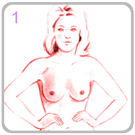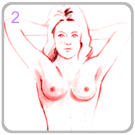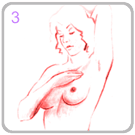Breast Cancer Awareness
Tata Memorial Hospital, Mumbai 400012
Breast cancer is the second most common cancer in Indian women. The incidence is more in urban than rural women. It is more prevalent in the higher socio-economic groups. Women of the Parsi community face a higher risk. The average incidence rate varies from 22-28 per 100,000 women per year in urban settings to 6 per 100,000 women per year in rural areas. Due to rapid urbanization and westernization of lifestyles, there is a rising incidence of breast cancer in India. According to The International Agency for Research on Cancer, which is part of the World Health Organisation, there were approximately 79,000 women per year affected by breast cancer in India in 2001 and over 80,000 women in 2002.
Typically, breast cancer arises from cells lining the milk ducts and slowly grows into a lump. It is thought that it takes about 10 years for a tumour to become 1 cm in size starting from a single cell.A malignant tumour has the ability to spread beyond the breast to other parts of the body via the lymphatics or the blood stream.
Preventable and Non-Preventable Breast Cancer Factors
Several factors can contribute to developing breast cancer. Some of these factors are lifestyle choices and some are biological characteristics. The biological characteristics encoded in DNA are factors that cannot be controlled. The other factors, however, can be controlled to prevent an increased risk for breast cancer.
Non preventable breast cancer factors include:
Family pre-disposition:
If a family member has developed breast cancer in the past, or currently has breast cancer, women in that immediate family have a greater risk for breast cancer than those without family history. If you have a grandmother, mother, sister, or daughter who has been diagnosed with breast cancer, this does put you in a higher risk group. See your doctor at any sign of unusual symptoms.
Age:
As women become older, the risk for breast cancer increases. Most cases of breast cancer are found in women over 40,though the number of younger women developing breast cancer is currently on the rise.
Race:
Breast cancer is diagnosed more often in white women than Asian, or African women. The reason for this has yet to be defined, but women of all races should still be concerned.
Reproductive and menstrual history:
Women who experienced their first menstrual cycle before age 12, had their menopause after age 55, and/or never had children are at an increased risk of breast cancer.
Preventable breast factors include
Body weight:
People who are obese or overweight face a greater chance of developing breast cancer than those who are of a normal weight. A woman who exercises four hours per week reduces her risk of breast cancer. Exercise pumps up the immune system and cuts the estrogen level.
Smoking:
Many people are aware that smoking increases lung cancer risk, but it also increases breast cancer risk as well. One recent study indicated there may be a link. Studies of the relationship of breast cancer to cigarette smoking and second-hand cigarette smoke are still under investigation. However, smoking decreases your survival rate once you have been diagnosed with breast cancer.
Drinking Alcohol:
Excessive alcohol consumption, more than one drink a day, can lead to a higher risk for breast cancer. Studies show that breast cells are exposed to higher levels of estrogen when consuming alcohol. This may trigger the cells to become cancerous. The more alcohol you drink, the higher your risk.
Diet :
Eat a low-fat, nutritious diet. A high-fat diet increases the risk of breast cancer. Fat triggers the hormone estrogen, that fuels tumor growth. Fill your diet with plenty of fruits and vegetables.
How to help prevent breast cancer (steps to self exam)
Be breast aware
To be breast aware means becoming familiar with how your breasts look and feel. You should understand how your breasts may change at different times during the month and also as you get older. For some women, breasts become enlarged, tender and lumpy just before a period, and then return to normal once the period is over, others may have swollen breasts throughout their cycle. Age, pregnancy,and the menopause can all affect the size and feel of your breasts. The important thing is to recognise which changes are usual and which are not. Make sure you know what is normal for you.
These are the five steps to self examination that every woman should practice every month.
Step 1: After a bath , step in front of a large mirror and put your hands on your hips. Look at the size, shape, and color of your breasts. They should look as they normally do with no visible dimples,puckering,or swelling.

Step 2: Raise your arms above your head and clasp your hands together. Examine your breasts as you did in step one and look for dimples, puckering, swelling, rashes, or inverted nipples.

Step 3: Place your arms at your side and gently squeeze each nipple between finger and thumb to check for any discharge.
Step 4: Next, lie down, and use your right hand to feel your left breast and then your left hand to feel your right breast. Taking three fingers, firmly press the breast in small circles from top to bottom and side to side. Make sure to go as far as the collarbone to the top of the abdomen and from cleavage to armpit. Do this three times, first with a soft touch, then with increased pressure, and on the very last time press firmly and deeply.
Step 5: Finally, either sitting in a chair or standing, feel your breasts as you did in step four.

By doing this women can not only become more familiar with their breasts, but can sense breast problems before they become too serious.
- Painless lump in the breast
- Dimpling of skin over breast
- Change in contour over the breast
- Rash or ulcer over the nipple
- Indrawing of the nipple
- Blood stained discharge through the nipple
- Ulceration of the nipple
- Lump or fullness in the armpit
- Arm swelling
If any of these is found in the breast self examination , then you should consult your doctor. Please remember that early detection leads to complete cure. The survival rates for early breast cancer are excellent and these women lead healthy normal lives.
Some common myths and misconceptions about breast cancer
Myth: Finding a lump in your breast means you have breast cancer.
Truth: Eight out of ten lumps are benign, or not cancerous. If you discover a persistent lump in your breast or any changes in breast tissue, it is very important that you see a doctor immediately. Sometimes women stay away from medical care because they fear what they might find. Take charge of your own health by monthly self-exams, regular visits to the doctor, and regularly scheduled mammograms.
Myth: Men do not get breast cancer.
Truth: While the percentage of men who are diagnosed with breast cancer is small, men should also give themselves monthly exams and note changes to their doctors. Breast cancer in men is more aggressive and tends to be detected late, due to which the prognosis becomes poorer for men.
Myth: A mammogram can cause breast cancer to spread.
Truth: An x-ray of the breast is called a mammogram. The x-ray and the compression on the breast from the x-ray machine cannot cause cancer to spread.
Myth: Having a family history of breast cancer means you will get breast cancer.
Truth: While women who have a family history of breast cancer are in a higher risk group, most women who have breast cancer have no family history. If you have a mother, daughter, sister, or grandmother who had breast cancer, you should have a mammogram five years before the age of their diagnosis.
Myth: Breast cancer is a communicable disease.
Truth: You cannot catch breast cancer or transfer it to someone else's body. Breast cancer is the result of uncontrolled cell growth in your own body.
Myth: Using antiperspirants can increase the risk of breast cancer
Truth: There is no evidence supporting the myth that using any common deodorants or antiperspirants increases the risk of breast cancer..
Myth: Taking birth control pills can give you breast cancer
Truth: This misconception is due to the fact that birth control pills contain doses of hormones used to regulate the menstrual cycle. Though these hormones, estrogen and progesterone do not cause women to develop breast cancer, several studies have concluded that taking birth control pills may slightly increase the risk of breast cancer later in life. This theory is still being tested, and as of now, there is no definite answer to this theory.
Myth: Surgery for breast cancer means removal of whole breast (Mastectomy)
Truth: For early breast cancer, there is no need for removal of the whole breast .It has been proved in several trials that breast conservation surgery is equally safe and effective as mastectomy and the cosmetic results are excellent.
Global Navigation
Contact Us
TATA MEMORIAL HOSPITAL
Dr. E Borges Road, Parel, Mumbai - 400 012 India
Phone: +91-22- 24177000, 24177300, 69537300
Fax: +91-22-24146937
E-mail : msoffice@tmc.gov.in(for patient care and queries)/cash@tmc.gov.in(for accounts related)/fundraising@tmc.gov.in (for donors and donation related)/registrar@tmc.gov.in(for education and training)/hrd@tmc.gov.in(for administrative - HRD matters)

